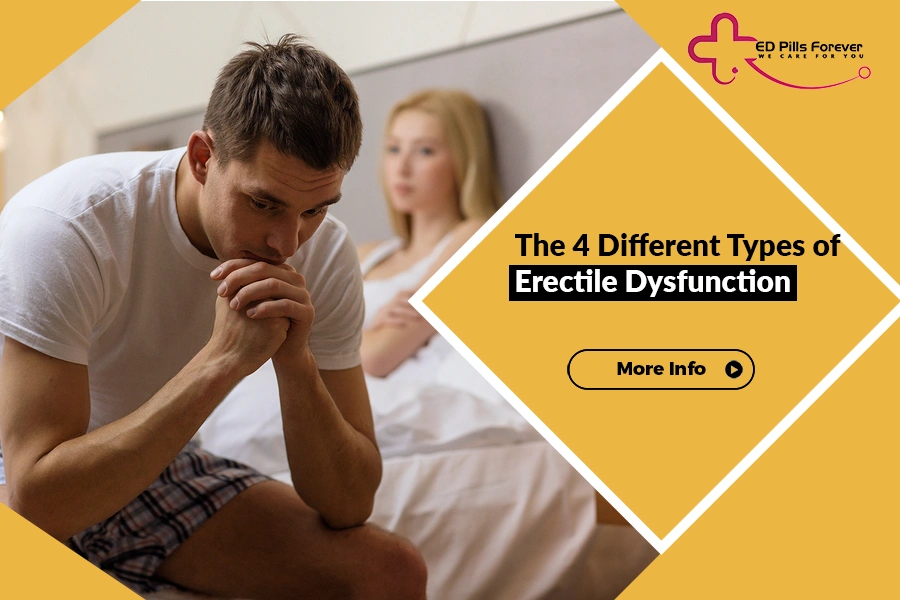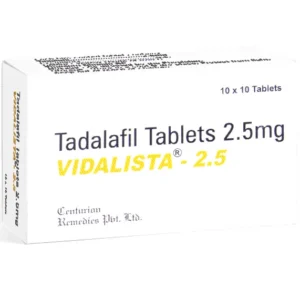Let’s be real, talking about erectile dysfunction isn’t exactly dinner table conversation. It’s one of those topics men often avoid, pretending it doesn’t exist until it becomes impossible to ignore. But here’s the thing: it’s way more common than most people think. Millions of men worldwide experience some form of ED, and yet, we still treat it like a taboo secret.
You might be wondering, “Why does it happen? And are there actually different kinds of erectile dysfunction?”
Yes, there are. And understanding the types of ED is the first real step toward fixing it, not just covering it up.
What Is Erectile Dysfunction, Really?
Before diving into the types, let’s get on the same page about the meaning of erectile dysfunction. In simple terms, it’s when a man consistently struggles to get or keep an erection firm enough for sexual activity.
That said, what is ED in medical terms? Medically, it’s defined as the persistent inability to achieve or maintain an erection adequate for satisfactory sexual performance. Notice the word persistent, because every guy has an off day once in a while. That doesn’t count.
It’s when this issue keeps repeating, that’s when we start looking into causes of impotence erectile dysfunction seriously.
Interestingly, erectile dysfunction isn’t just a “down-there” problem. It’s often a signal, like a warning light blinking on your car dashboard, that something deeper (physically or psychologically) needs attention.
Type 1: Psychological (Or Emotional) Erectile Dysfunction
Now, let’s start with the sneakiest one.
Psychological erectile dysfunction is all about what’s going on in your head, not your body. Stress, anxiety, guilt, fear of failure, depression these mental factors can completely hijack your body’s sexual response.
Think about it: your brain controls everything. If your head’s not in it, your body won’t be either.
I remember interviewing a therapist once who specialized in sexual health. He told me, “For a lot of men, their mind is the biggest barrier to their erection.” And it makes perfect sense. Performance anxiety is like a loop, you worry you won’t perform, so you don’t, and that just reinforces the fear next time.
In younger men, this type of erectile dysfunction is actually the most common. They’re physically healthy, but stress from work, relationships, or even just overthinking can short-circuit their arousal.
What helps? Therapy, mindfulness, and honest conversations both with yourself and your partner. Sometimes, a bit of reassurance can be more powerful than any impotence medication.
Type 2: Vascular (Or Circulatory) Erectile Dysfunction
Here’s where it gets a little more biological.
Your erection depends on good blood flow, plain and simple. If blood isn’t moving properly into or staying inside the penis, you’re going to have trouble keeping things firm.
This is the most common cause of erectile dysfunction in older men. Conditions like heart disease, atherosclerosis (clogged arteries), high cholesterol, or even smoking can all narrow blood vessels. And when that happens, less blood reaches the penis.
To be honest, this type of ED can also be an early warning sign of cardiovascular issues. In fact, some studies suggest impotence and erectile dysfunction may appear years before heart disease symptoms do.
That’s why doctors often treat ED as a red flag, it’s not just about sex, it’s about your overall vascular health.
The good news? Improving circulation through diet, exercise, and quitting smoking can make a massive difference. And if needed, erectile dysfunction medicine like PDE5 inhibitors (you’ve probably heard of Viagra or Cenforce) can help restore proper function while you work on the underlying cause.
Type 3: Neurological Erectile Dysfunction
This one’s trickier.
Your nervous system brain, spinal cord, and peripheral nerves all play crucial roles in triggering and maintaining an erection. If any part of that communication line is disrupted, the signal just doesn’t get through.
Neurological ED can happen because of conditions like Parkinson’s disease, multiple sclerosis, stroke, spinal injuries, or even long-term diabetes.
I once read a case study about a man who suffered from mild ED after a minor spinal injury not because of physical damage to the penis, but because the nerve signals weren’t firing properly. That’s how interconnected our systems are.
What’s even more fascinating (and frustrating) is that sometimes, this type overlaps with the psychological one. A guy might start with nerve-related ED, but the anxiety around it makes things worse mentally. It’s like a vicious circle.
Treatment here depends on the cause. Some men benefit from medications, others from devices like vacuum pumps, and some from physical therapy or neurostimulation techniques. It’s not a one-size-fits-all deal.
Type 4: Hormonal (Or Endocrine) Erectile Dysfunction
Hormones are like your body’s internal conductors, when one’s off-beat, the whole orchestra sounds wrong.
Low testosterone is often blamed for erectile dysfunction, and for good reason. Testosterone helps regulate libido, erection strength, and even mood. But it’s not the only hormone at play: thyroid disorders, high prolactin, and insulin resistance can also mess with your sexual function.
You might not feel it right away, but signs like fatigue, low sex drive, or even depression can hint that your hormone balance is off.
Doctors usually test blood hormone levels to confirm. If it’s hormonal, treatment can involve hormone replacement, medication, or lifestyle adjustments. Sometimes, just fixing your sleep and diet can boost testosterone naturally.
That said, don’t rush to self-diagnose. It’s not as simple as you think popping testosterone boosters without guidance can actually make things worse.
Best Seller
Best Seller
The Blurred Lines Between Types
Here’s the thing, most men don’t fall neatly into one category. A man with diabetes might have vascular issues, but also psychological stress about his performance. Another might have hormonal imbalances and nerve-related complications.
It’s rarely black and white.
That’s why doctors don’t just prescribe pills; they ask questions, run tests, and look at the big picture. Because treating erectile dysfunction means addressing the man, not just the symptom.
And let’s be honest, when a man’s hard issue shows up, it hits more than just the body. It touches pride, self-image, relationships, and sometimes even mental health.
The Modern Approach: Breaking the Silence
We’re finally getting to a point where men are talking about these things openly and that’s a huge step forward.
Back in the day, ED was whispered about behind closed doors. Now, thanks to social media and health awareness campaigns, it’s easier to say, “Yeah, I’m dealing with this, and I’m getting help.”
Modern impotence medication and therapy options are more effective and safer than ever before. But even more important than the medicine is the mindset of understanding that erectile dysfunction doesn’t make you “less of a man.” It’s a medical condition, just like high blood pressure or diabetes, and it’s treatable.
So, What Can You Do?
If you’re experiencing any form of ED, the first step is honesty with yourself and your partner. Then, talk to your doctor. Simple blood tests, physical exams, or even psychological evaluations can pinpoint the problem.
Sometimes, just identifying the types of impotence can help you feel more in control. Because when you know why it’s happening, you can start taking steps to fix it.
Lifestyle plays a huge role too, exercising, eating right, sleeping well, and reducing stress can all improve your ed level and boost performance naturally.
Final Thoughts
To be honest, writing about erectile dysfunction feels personal. I’ve spoken to countless men, some young, some older, who’ve gone through it quietly, too embarrassed to ask for help. But what struck me most was how relieved they felt once they realized they weren’t alone.
It’s not a moral flaw, not a reflection of masculinity, just a condition with many causes and many solutions.
And whether your ED is psychological, vascular, neurological, or hormonal, the outcome can improve. You just have to take that first, often awkward, step toward help.
Because no man should have to suffer in silence when the answers and the treatments are out there.
FAQs
1. What is ED in medical terms?
In medical language, erectile dysfunction (ED) means the consistent inability to get or keep an erection that’s firm enough for satisfying sexual activity. It’s not about occasional issues everyone has, but when it becomes persistent, doctors treat it as a medical condition.
2. What causes impotence and erectile dysfunction?
There isn’t just one cause. Physical issues like poor blood circulation, diabetes, or nerve damage can lead to ED. But psychological factors such as stress, anxiety, or depression can play a major role too. Sometimes, it’s a mix of both mind and body.
3. What are the different types of ED?
There are four main types: psychological, vascular, neurological, and hormonal. Each affects erections differently, some are linked to emotions, others to blood flow, nerve function, or hormone balance. Knowing which one you’re dealing with helps guide the right treatment.
4. Can medication help treat erectile dysfunction?
Yes, several erectile dysfunction medicine options are available today. PDE5 inhibitors like Viagra, Cialis, or Cenforce work by improving blood flow to the penis. However, the best results come when you also address the underlying cause, not just the symptom.
5. Is ED permanent or curable?
In most cases, no, it’s not permanent. Once the root cause is identified, lifestyle changes, therapy, medication, or hormonal treatment can significantly improve or even reverse ED. So if you’re struggling, it’s absolutely worth speaking to a healthcare professional.

































